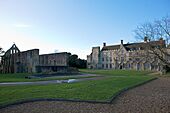Battle Abbey facts for kids

Battle Abbey – Gate House
|
|
| Lua error in Module:Location_map at line 420: attempt to index field 'wikibase' (a nil value). | |
| Monastery information | |
|---|---|
| Established | 1094 |
| Disestablished | 1538 |
| Dedicated to | St Martin of Tours |
| Consecrated | 1094 |
| People | |
| Founder(s) | William I of England |
| Architecture | |
| Heritage designation | Scheduled monument |
| Designated date | 11 July 1928 |
| Site | |
| Location | Battle, East Sussex |
| Country | England |
Battle Abbey is a historic place in Battle, East Sussex, England. It was once a large Benedictine abbey, but now much of it is in ruins. The abbey was built on the very spot where the famous Battle of Hastings took place in 1066. It was dedicated to St Martin of Tours. Today, it is a protected Scheduled monument, meaning it's an important historical site.
English Heritage now looks after the site, calling it 1066 Battle of Hastings, Abbey and Battlefield. Visitors can explore the old abbey buildings and ruins. There's also a visitor centre with a film and exhibition about the battle. You can take audio tours of the battlefield and see old items found at the monks' gatehouse. The centre even has a discovery room for kids and an outdoor playground.
Contents
History of Battle Abbey
How the Abbey Started
William the Conqueror, who won the Battle of Hastings, promised to build a monastery if he was victorious. In 1070, Pope Alexander II told the Normans to make up for the many lives lost during their Norman Conquest of England. William decided to build an abbey right where the Battle of Hastings happened. The main altar of the church was meant to be exactly where King Harold Godwinson fell in battle on October 14, 1066.
William started building the abbey, but he passed away before it was finished. His son, William II of England (also known as William Rufus), completed the church around 1094. It was a very important place, designed for many monks. The first monks came from another abbey in France.
William I made sure the church of St Martin of Battle had special rules. It was free from the usual church laws and had many special rights. For example, it was a place of sanctuary, meaning people could find safety there. The head of the abbey, called the abbot, was very powerful. He even had a seat in Parliament and could pardon criminals on their way to execution!
The abbey also kept a famous list called the "Battle Abbey Roll." This list was said to contain the names of all the important people who came with William from Normandy. Over time, more names were added to this list, as it became a great honour to be on it.
When the Abbey Closed Down
The abbey church was rebuilt in the late 1200s. However, it was almost completely destroyed in 1538 during the dissolution of the monasteries. This happened when King Henry VIII decided to close down many monasteries across England. At that time, there were seventeen monks living at Battle Abbey.
King Henry VIII gave the abbey and its lands to his friend, Sir Anthony Browne. Sir Anthony pulled down the church and parts of the monks' living areas. He then turned the abbot's house into a country home for himself.
Later Years of the Abbey
The abbey changed hands several times over the centuries. In 1721, it was sold to Sir Thomas Webster. The Webster family owned Battle Abbey until 1857. Later, it was bought by Lord Harry Vane, who became the Duke of Cleveland.
After the Duchess of Cleveland died in 1901, the Webster family bought the estate back. Sir Augustus Webster, the 8th baronet, was the last of his family to own it. He passed away in 1923. For a while, the abbot's house was used as an all-girls boarding school. During the Second World War, Canadian troops were stationed there.
Battle Abbey Today
In 1976, the Webster family sold Battle Abbey to the British government. Now, English Heritage takes care of it. Experts have studied the old wooden parts of the gatehouse and other buildings. They found that different parts were built at various times in the 1400s.
The spot where King Harold is believed to have died is now marked by a special plaque on the ground. Nearby, there's a monument to Harold that people from Normandy put up in 1903. The abbey ruins and the battlefield are very popular with tourists. Special events, like Battle of Hastings reenactments, are often held there.
While the abbey church itself is mostly just an outline on the ground, some parts of the other abbey buildings still stand. These parts, built between the 1200s and 1500s, are now used by the independent Battle Abbey School. Visitors usually can't go inside the school buildings. However, during the school's summer holidays, you can sometimes visit the abbot's hall.
The ruins of the church were also used as a filming location. The band Black Sabbath filmed their music video for "Headless Cross" there in 1989.
Burials
Gallery
See also
 In Spanish: Abadía de Battle para niños
In Spanish: Abadía de Battle para niños
- Abbot of Battle, a list of abbots of Battle Abbey
- Battle Abbey Roll
- List of monastic houses in East Sussex
- Senlac Hill
- Odo of Canterbury









